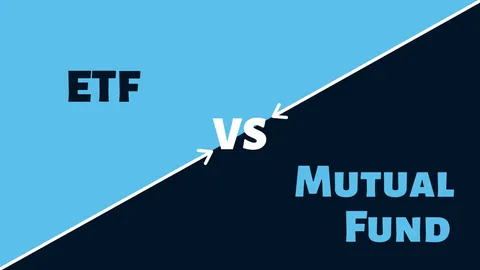ETF Vs Mutual Funds For Beginners
I strongly recommend that new investors who are unfamiliar with investing in ETFs or mutual funds familiarize themselves with the concepts, as they might prove helpful in appreciating their financial growth in the long run. This is because both allow for easier market entry and portfolio diversification but have different features that suit various investment objectives and styles. Mutual funds and ETFs are methods of investing in several securities with a single transaction, which mitigates risk. However, how they transact, their expenses, and their tax implications differ. Here, we will look at each of them to help you decide which is responsible for our financial objectives.
What Are ETFs?
ETFs are investment funds that trade on stock exchanges holding several security shares of a corporation, such as bonds. This means that an ETF is an investment tool composed of various investments, and therefore, it can increase your portfolio all in one transaction. Since they have an underlying when bought, for instance, stocks, ETFs can be traded during the day at market prices, making things very easy. This feature might be handy to investors who anticipate rapid moves in the market and want the temperament to do so.
Definition of Mutual Funds
The concept involves consolidating the funds of several participants to purchase shares in several companies at once. Hunting for a wider variety of investments, fund managers oversee all activities aiming to achieve the investment goal – growth, making income, or both. Shares of mutual funds are not traded on the stock exchange; their purchasing or sale is made based on the mutual fund’s net asset value at the close of business. Mutual funds are ideal for investors looking for more automated solutions since mutual funds are comprised of firms or individuals making investment decisions.
Cost Differences Between ETFs and Mutual Funds

The primary reason it is suggested that one invests in mutual funds rather than exchange-traded funds is cost. ETFs are relatively cheap to own since they have low expense ratios and are ideal for long-term investors. Because investment strategies in these funds are behaviorally passive and objective, meager management fees are incurred by funds that follow a market index. Most of the time, actively managing mutual funds charges higher management fees for the services of a professional manager. All things being equal, these fees will affect the return in the long run, especially for investors who have cost-effective growth in mind.
Nature of trade for ETFs and Mutual Funds
One of the critical aspects that Sets Apart ETFs and mutual funds is the way they are traded. ETFs are listed on an exchange and can be traded throughout a particular day, enabling investors to respond to changing market conditions. This characteristic of intraday trading might appeal to investors with a more aggressive investment strategy. While mutual funds can only be purchased or sold at the end of the day at a price that the NAV determines, such limitations seem optional for investors who are not in a great hurry and need the funds later.
Diversification in ETFs and Mutual Funds
Risk in investments can be controlled through diversification, a principle common to mutual funds and ETFs. One area in which ETFs stand out is their targeted diversification based on particular themes, sectors, or indexes. There is an ETF that specializes in technology stocks or invests exclusively in emerging markets, for example. This allows the investor to spread the funds over niches and regions. At any rate, a mutual fund could invest in almost any asset, such as a stock, bond, or a variety of targeted/focused funds, and get the desired level of diversification.
Risk Factors in ETFs and Mutual Funds
Whatever the case, there are risks associated with both ETFs and mutual funds, which are available in the market now and that potential investors need to keep in mind. Based on the findings and due to the nature of most ETFs, they are prone to market risk, which means that the worth changes with the sector or index for which they were developed. However, elevated risk seems to emanate from factors other than market fluctuation because they are not frequently managed, which comes with actively managed equities or funds. On the other hand, actively managed mutual funds fall under both market risk and management risk. If there is low performance across sectors, the different risk levels are the managers’ investment managers. Eric’s fg is that the low performers envisage poor returns across all sectors, while the out-performers outperformers have aggressive strategies. Another strategy employed by mutual funds involves. These include moderate to conservative profiles like 30% bond funds, giving cautious investors low-risk positions.
Tax Implications of ETFs and Mutual Funds
If tax matters are of concern, ETFs might be the better option due to the nature of their structure. This creates an environment where taxes on profits earned through ETF virtual transactions are less since such securities are exchanged in the stock market. As for mutual funds, all funds ensure that sales profits or any other form of gains, such as real estate, are shared across all funds and non-selling shareholders. Investors who are focusing on minimizing tax borders must also take such shortcomings into account because they could have an impact on future strategies. Providing tax amnesty for the funds could suffice for a person in the upper bracket or someone looking to grow their money over time.
Management Styles: Active Vs Passive
Yet another point in the ETF and mutual fund debate is fund management style. Even though many ETFs were created to track an index, sector, or asset class passively, some active management is done, leading to lower management costs. Still, professional management gives more weight to prospects in beating the market. Therefore, mutual funds tend to be more aggressive. This will likely increase the management fee, but a better return is also expected. Those who think that when they get ideologically involved in stocks, it is better not to get too involved personally would favor ETFs, while those who want to delegate the hard work to a fund manager would go for mutual funds.
Earning Passive Returns: Dividend ETFs and Income-Generating Mutual Funds
ETFs and mutual funds with an explicit provision to earn income can be pretty helpful. By investing in the stock of companies that issue dividends, dividend ETFs enable passive investors to earn a steady flow of cash for investing. The same goal of bringing income to shareholders can be sought in income-generating mutual funds, which generally consist of bonds or high dividend-paying equities, serving the same purpose of generating revenue. At the same time, investment is mainly passive, changing the returns. Understanding such fine distinctions allows investors to become selective in their choice of funds, depending on their income generation preferences.
Liquidity Differences Between ETFs and Mutual Funds
Another key distinction that sets ETFs apart from mutual funds relates to liquidity. ETFs are extremely liquid and can be easily purchased or sold during market hours, providing quick access to the funds. On the other hand, mutual funds only carry out transactions once at the end of the trading session. ETFs allow many common investors who need liquidity more often to have it at their disposal. For other investors who may be able to sit long, mutual funds will not be an issue regarding pricing and liquidity.
Access and Minimum Investment Requirements
As noted above, access to ETFs and mutual funds is not uniform across the board, especially regarding the minimum investment requirements. In most eras, trading units can be bought with no minimum investment through a broker’s account, which is suitable for novice investors. In contrast, mutual funds normally have a minimum investment requirement, and this figure differs considerably from one fund to another. This is preferable to first-time investors who do not wish to make a large investment because of the risk involved, allowing them to invest through ETFs in less.
What is easier for new starters: ETFs or Mutual Funds?
The choice between ETFs and mutual funds depends on investment aspirations, budget, and risk appetite. Clients looking for lower commissions, ease of trading, and taxation efficiency might find ETFs more suitable. Those who are more ‘hands-off’ regarding their investments’ growth and willing to pay a bit more in fees are likely to appreciate the positive attributes of mutual funds. Mutual funds encourage beginners to construct a diversified portfolio consistent with their financial goals and requirements by encouraging them to make sophisticated investment decisions.
Conclusion
ETFs and mutual funds possess relative advantages, making them important tools for beginning investors to construct long-term portfolios. Cost-effectiveness, flexibility, and lower levels of taxation make ETFs attractive, while professional management and a variety of products will please those who prefer mutual funds. As the marketplace and individual self-interest change, a portfolio containing some combination of ETFs and mutual funds can be a smart way to achieve growth while controlling risks. Recognizing these disparities helps investors protect themselves and, in this way, achieve their investment objectives.



